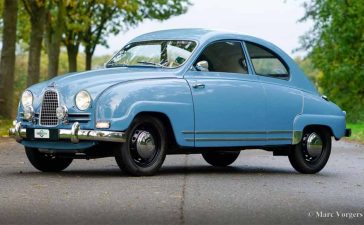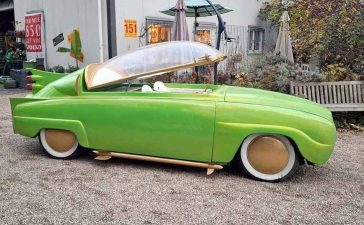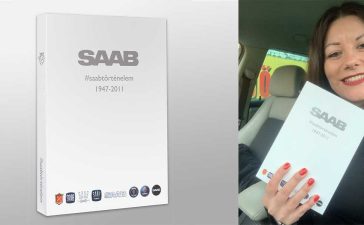When the last Saab left the line
In April 2010, Saab launched what would unknowingly become its final flagship: the Saab 9-5 NG (New Generation). Built on GM’s Epsilon II platform yet dressed in unmistakably Scandinavian design, this model symbolized both Saab’s rebirth under Spyker and its impending demise. Production lasted barely a year, with just 11,280 units leaving Trollhättan before bankruptcy shut the doors forever in December 2011.
More than a decade later, the 9-5 NG still sparks debate. Was it a compromised GM derivative, or proof that Saab’s designers could still inject character into corporate bones? Recently, KiwiCarLife, a New Zealand YouTube channel run by musician and car enthusiast Liam Kendrew, offered his take. Reviewing a rare 2010 Saab 9-5 2.0 Turbo – the only example in New Zealand – he approached the car not as a Saab loyalist, but as an intrigued outsider. His perspective reveals both the model’s enduring charm and its shortcomings against rivals.
Atyling: Saab design shines through GM bones
One of Saab’s undeniable strengths has always been styling that ages gracefully. From the wraparound windshield of the 99 to the teardrop form of the 900, Saab made cars that stood apart. The 9-5 NG continued that tradition with its “ice block” headlights, clamshell hood, and aircraft-inspired lines. Even Kendrew, with little Saab background, called it “a pretty car” compared to the Opel Insignia on which it was based.
Yet beneath those flowing surfaces lay GM familiarity. The resemblance to Holden’s ZB Commodore or Opel/Vauxhall Insignia is unmistakable if you squint. What Saab achieved was essentially a Scandinavian suit over Detroit tailoring—but the exterior’s execution was good enough to mask the corporate underpinnings.
Today, more than 14 years after production ended, the 9-5 NG’s styling remains modern. Many enthusiasts argue it previews design directions later seen in brands like Volvo and even Audi. For Saab, it was a confident last word in aesthetics.
Under the hood: shared engines, limited uniqueness
Kendrew’s test car carried the 2.0L turbocharged four-cylinder, producing 220 hp (162 kW) and 350 Nm of torque. Other options included a smaller 1.6T, and the muscular 2.8L V6 turbo shared with Opel’s Insignia VXR. Transmission choices were a six-speed manual or the GM-sourced Aisin six-speed automatic, as fitted here.

On paper, these specs looked competitive in 2010. Yet compared with German rivals like the Audi A6 (C7), BMW 5 Series (F10), and Mercedes-Benz E-Class (W212), Saab’s lineup lacked depth. Saab offered front-wheel drive as standard, with all-wheel drive reserved for certain trims.
Kendrew noted that under the bonnet, “you’d think you were looking at a Commodore,” a reminder of Saab’s dependence on GM parts. This was both Saab’s lifeline and its curse—access to proven technology, but at the cost of distinctiveness.
Interior: Saab touches amid Commodore familiarity
Step inside, and the 9-5 NG reveals its dual nature. The steering wheel, light switches, and start-stop button are straight from Holden’s catalog. The handbrake, too, is pure GM. For an enthusiast expecting quirky Swedish originality, it feels more Melbourne than Trollhättan.
But Saab’s designers still made their mark. The Night Panel feature, which dims all gauges except the speedometer for nighttime driving, remained intact. Green-lit dials, aviation cues, and sculpted seats reminded drivers that Saab’s DNA had not been erased. Rear passengers benefited from generous space, while front occupants enjoyed plush seating despite the beige trim choice in this example.
To Saab fans, these touches matter. For Kendrew, they were enough to elevate the car “just that little bit more special” than a rebadged GM sedan.
Driving impressions: Comfort over sport
On the road, the review paints a picture of a quiet, soft-riding sedan. Kendrew emphasized the smoothness of the Aisin automatic, with nearly imperceptible shifts and relaxed power delivery. The 2.0 turbo provided adequate acceleration, capable of overtakes but far from thrilling.
“The steering is pretty vague,” he noted, and the suspension tuning leaned heavily toward comfort. Compared with German competitors capable of storming down the autobahn at 250 km/h, the Saab felt more like an upmarket Toyota Camry—stable and refined, but not dynamic.
Yet this comfort is precisely what many Saab owners prize. In markets like Sweden, where long winter drives and rough roads test a car’s civility, Saab’s focus on ride quality and stability made sense. To outsiders, however, it risked being dismissed as bland.
Competition in 2010: The wrong battlefield
When the 9-5 NG launched, it faced a brutal set of rivals:
- Audi A6 C7 (newly introduced with advanced tech)
- BMW 5 Series F10 (benchmark for driving dynamics)
- Mercedes-Benz E-Class W212 (comfort and prestige leader)
Against this trio, Saab’s newcomer lacked the performance edge, badge prestige, and dealer network. Even Kendrew concluded that “the Germans just do a large comfy sedan better.” Saab could not compete on scale or perception, and GM’s abandonment left the company without the resources to refine the 9-5 NG further.
Still, in design terms, the Saab arguably looked fresher than its contemporaries. Its wraparound glasshouse and uncluttered surfaces gave it an identity that many luxury sedans lacked.
Rarity and legacy: a car cut short
Production of the 9-5 NG was tragically brief. Just 11,280 units were built, with a small fraction reaching markets outside Europe. Kendrew’s test car, imported from Singapore, remains the only known example in New Zealand. For enthusiasts, this rarity elevates its appeal.
In markets like the US, where fewer than 6,000 units were sold, the 9-5 NG has become a collector’s conversation piece. Clean examples fetch significantly more today than five years ago, especially high-spec Aero V6 AWD versions. Its short life only intensifies its mystique—a modern classic created by circumstance, not intention.
An outsider’s view: Saab through fresh eyes
What makes Kendrew’s review compelling is that he is not a Saab loyalist. He approaches the car without nostalgia, evaluating it as one would any used luxury sedan. His verdict is clear: it is “lovely, smooth, comfortable, cool to look at,” but not exotic or particularly exciting.
And yet, he admits that driving it feels like handling “a bit of long-forgotten history.” That sense of piloting the last product of a once-radical company carries emotional weight. Even outsiders recognize that Saab meant something more than just another car brand—it represented individuality in an industry increasingly driven by conformity.
Saab still stirs emotions worldwide
The 2010 Saab 9-5 NG may not have matched the Germans in raw performance or prestige. Its GM underpinnings are obvious, and its driving experience leans toward comfort rather than excitement. Yet as Kendrew’s review shows, even a non-enthusiast feels the pull of Saab’s identity.
The fact that one Kiwi musician felt compelled to film and share his impressions of a single imported example speaks volumes. Saab may be gone, but the cars continue to spark curiosity, respect, and affection across the globe.
For the Saab faithful, the 9-5 NG is both a heartbreak and a triumph—a reminder of what could have been, and proof that even in its final hour, Saab built something distinctive enough to be remembered.












For me a timeless en stunning looking car.
Save the last one for … meeeee …
My 93 which i converted to a 2.3 and a noobtune map. 275bhp. Powrr flex bushed Sadly no longer on the road according to dvla
This’s so beautiful
I miss it. Good looking and smart
Nice looking car. I was thinking about buying but did not dare because of parts for the car after the bankruptcy.
Having owned three 9-5, two from new, if one had been available when I traded in my last one, I’d have a SAAB on my driveway instead of a Mercedes CLS. The silver one is a 2003 9-5 Vector 3.0 TiD. I traded that in for a 2005 Aero. In 2017, VN55BUU at 188,000 miles it needed a new clutch, brakes, tyres, full service – it was going to cost a couple of thousand; additionally, its performance was slipping a bit. (Nothing to do with the clutch) I then bought an identical FP55 NGU with only 68,000 miles. Its performance was like new. However, it suffered from multiple electrical issues. I sold that for a song and bought a (then) 3 yr old Mercedes CLS 350 CDI, now 8 years later with 120,000 miles it still looks and drives like new. But the cost of a set of tyres = £1,000. I just retired six months ago, hope I can afford to keep it up.
To Chris Riches>
I started buying the cheapest new tyres available (from about 12 years ago), rated for my 9-5 (around £70 ea) Quite honestly I couldn’t tell the difference in performance in the wet and they lasted well. Mind you I don’t throw my car around corners like I used to do either!
To Chris Riches >
great find ! I was surprised how i found no obvious difference between the cheapest and the Continentals and Michelins I used to buy ( though the Michelins used to wear very rapidly during the closest I ever got to ‘boy racer’ days…which wasnt very close 🤣)
I used to drive my 9-5 Aero at speeds i wont admit to. I took it to 140 mph on a German autobahn and it was still pulling when i eased off because of traffic. I just drove 100 miles round trip to Birmingham to help my 18 yr old grandson get a new wing for his Honda (he was crashed into by a hit and run on Saturday. The car was later found abandoned and on fire on the side of the A38) and I didn’t exceed the national limit by more than 5 mph. There are too many speed cameras on the so called ‘Smart Motorways’ M5/M42. And now I’m 72, I guess I should slow down a bit.
This car was one of 48 produced for the Singapore market.
40 were Vectors, 8 were Aeros.
Love my NG 95 aero TTid. Drives like a dream.
Hi, I have an emission problem with my 9-3, 2005. Can someone from the Detroit MI area recommend an auto shop that can make the repairs?